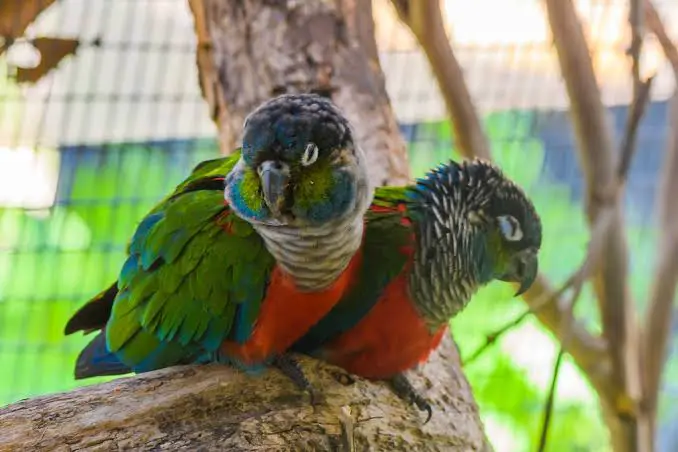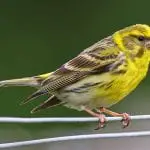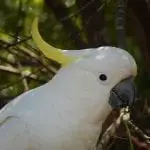Scientific Facts
| Common Name | Crimson Bellied Conure |
| Scientific Name | Pyrrhura perlata |
| Origin | south-central Amazon rainforest in Bolivia and Brazil. It also stretches its population between Madeira and Tapajós Rivers |
| Habitat | |
| Diet | seeds, berries, nuts, fruits, and even small insects |
| Size and Weight | Size: 9.3 in (24 cm) Weight: 2.8-3.3 oz (79-94 g) |
| Lifespan | Wild: 15 years Captivity: 20-30 years |
Physical Description
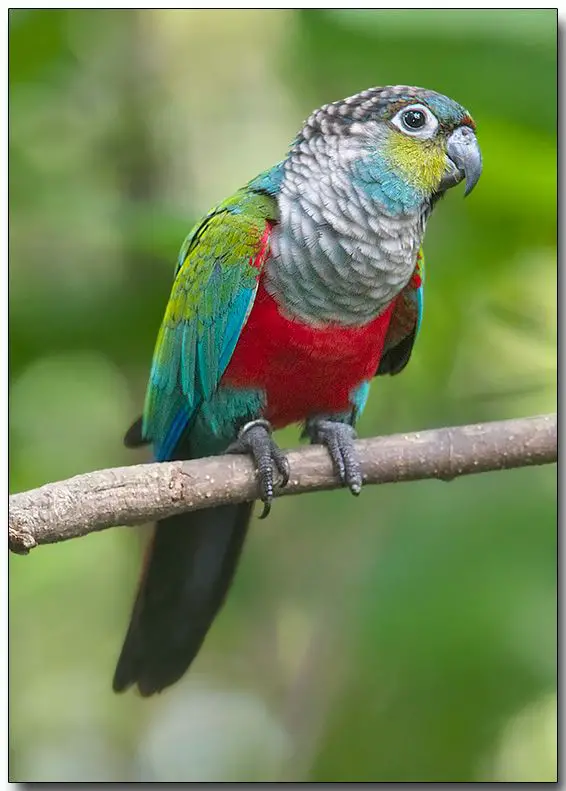
Crimson-bellied conure is characterized by their overpowering green color with hints of different colors scattered in their whole body. Their cheeks are in color yellow with splashes of blue on the lower part with a grey beak. They have a distinct blue-collar around their hindneck, take note that the appearance varies from one bird to another. They have a breast that is colored pale off-white with dark brown barring.
They have a colored red bend wing with a tail that consists of three colors, such as blue, red, and brown. Their eye-ring, which is in colored bare and white, complements its dark brown eyes. With all the color combinations in their body and interesting patterns make them one of the prettiest conures.
Where it is Seen?
It is an endemic parrot species to the south-central Amazon rainforest in Bolivia and Brazil. It also stretches its population between Madeira and Tapajós Rivers.
Habitat
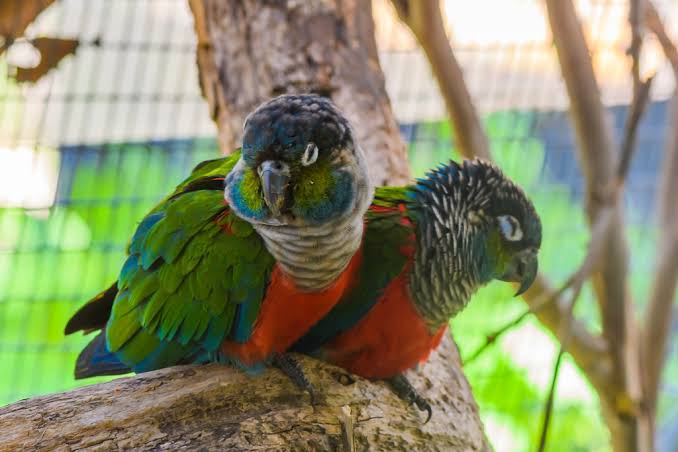
They prefer dense vegetation specifically within the forests of the Amazon basin and in the edges of humid lowland forest that has easy access to bodies of water since they love bathing a lot.
Subspecies
1) Pearly Conure (lepida)
They look a lot like the crimson-bellied conure, but the parts differ are the color of the abdomen, lower breast, and thigh area are in color as well. When it comes to their wings, crimson-bellied conure has a rounder shaped tail tips while pearly conure has a narrower wingtip.
2) Militia Pearly Conures (coerulescens)
This conure species looks like the same as the pearly conure, but this bird is characterized by its grey to brown breast color with hints of blue that stretches out until its throat. The under tail also has bluish tones. This conure species has a size of about 24 cm or 9.5 inches in length.
3) Neumann’s Pearly Conures (Amerithrax)
This conure species is the biggest con among the conure species. It is characterized by its green cheeks with a bluish lower chest, but as they grow older, these blue markings will slowly fade. The green markings on their wings have red markings that serve as their assets.
Behavior and Temperament
The Crimson-bellied conure is considered as one of the quieter conure species making them an ideal pet for apartment dwellers. Their natural calls are sometimes low chirps and whistles only that are rare and unobtrusive. Unlike other conures that show off their happiness and excitement through loud noises, these conures show these feelings through murmurs and soft, muffled chirps, which is usually heard during their playtime session.
They are cuddly conures that can form a bond with their favorite person. Even though they are not the best talkers, they can still be trained to mimic the sounds of barks and whistles. This species greatly depend on social interaction; when they are alone, you will notice that they will become noisier to get attention because when they feel neglected, they will soon die.
Breeding and Reproduction
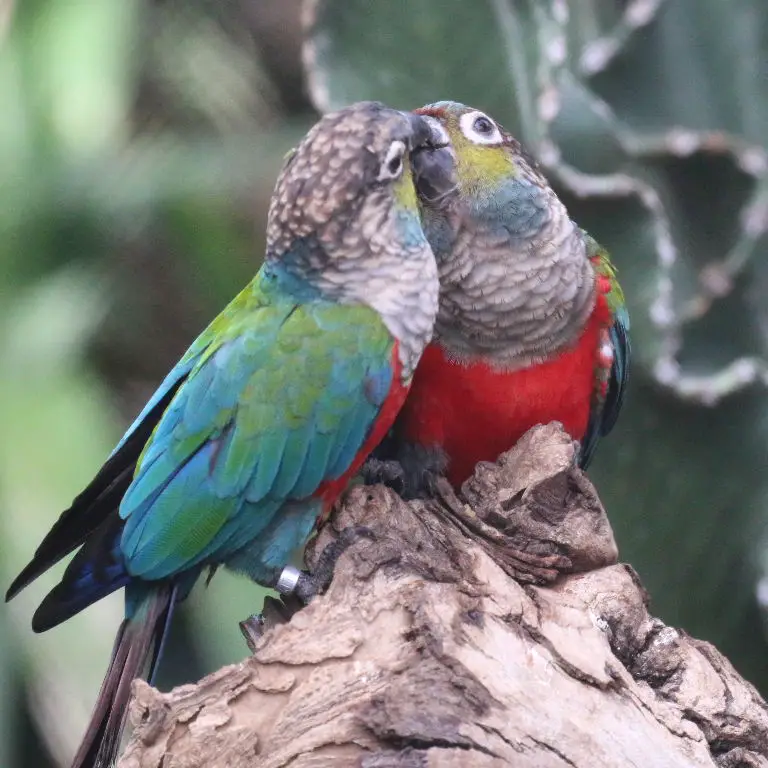
The crimson-bellied conure sexually matures at the age of 2. The breeding season takes place from April to November with a clutch size of 3-6 eggs. Both the male and female crimson-bellied conure can incubate the eggs for about 23-26 days, and they also take turns to feed their hatched juveniles. As soon as the bird develops its wings, the bird is ready to fly in about 50 days. Breeding crimson-bellied conures are quite complicated since they are prone to laying infertile eggs. They are also prone to a mutual disturbance that is why when you are planning to breed in captivity, make sure to have an isolated area for them.
Diet
Their main diet in the wild consists of seeds, berries, nuts, fruits, and even small insects. Usually, they stay in a place where there is a mineral-rich soil where seed-bearing trees grow. When temperature changes or when the season changed, they will migrate to another place where there they can see an abundance of food in one place.
Size and Weight
Their average size is about 9.3 in (24 cm) with a total weight of 2.8-3.3 oz (79-94 g).
Lifespan
The crimson-bellied conure is a hardy type of conure species; in captivity, they are not that susceptible to diseases compared to other conure species making their lifespan a bit longer. In the wild, they have up to 15-18 years lifespan while in captivity; if the conditions are optimal, they can reach up to 30 years.
Common Diseases/Illnesses
1) Psittacosis in Birds (Parrot fever)
Parrot fever is also known as chlamydophila, psittacosis, or ornithosis. It is an infectious disease that infests parrot species. It is spread out through the bird’s droppings or from their dust. These are the symptoms of Psittacosis disease: lack of appetite, depression, difficulty breathing, mucus discharge from eyes, and nose and Watery, green droppings.
If you see just one symptom, take it immediately to your veterinarian because it can cause sudden death of your bird if it is not treated immediately. Antibiotic treatment to kill the bacteria is necessary. You need to be cautious in handling them if you see some symptoms because psittacosis is contagious to humans that will bring very flu-like symptoms.
2) Polyomavirus
This infectious disease is common to both mammals and aviary. The impact of polyomavirus on the golden conure is fatal, especially to juveniles, because it directly impacts their immunity. If the bird has enough immunity to fight the infection, there is a higher chance that your conure would be able to survive. Research shows that the older the conure is, the more it develops immunity. It is not contagious to humans, but it can the disease can be transferable to other birds through their droppings and if humans touch an infected bird and then hold another bird.
Conure species are more prone to polyomavirus among the parrot species. The symptoms of polyomavirus are loss of appetite, vomiting, diarrhea, dehydration, weight loss, and swollen abdomen. There is no cure for this disease; once the bird gets infected, the bird will be weak slowly and soon die. There is a vaccination to avoid this disease, but it is advisable to do it before the bird develops its wings. Make sure that the environment where you would take your pet is always hygienic.
3) Pacheco’s disease
This is caused by a herpes virus that can be spread easily through nasal discharge and feces. It is not contagious to humans, but birds are more susceptible to this disease if they are stressed or depressed, especially over the loss of their cage mate. The symptoms of this disease are sinusitis. Lethargy, tremors, anorexia, and green droppings. These symptoms may often lead to sudden death. There is an antiviral drug that is used to combat this disease, but its side effects can cause kidney damage; that is why quarantine is a preventative measure.
4) Giardia
This is an intestinal infection that is caused by parasites. When the bird is infected with this disease, their feces have cysts that van be contagious to other birds. Your bird is susceptible to this disease if the food that you are giving to them as well, as the water sources are dirty. It is also contagious to humans if the water supply that they drink is the same as the bird. Giardia symptoms to golden conures are dry itching skin, diarrhea, bulky stools, weight loss, and depression.
5) Malnutrition
The most common diseases or illnesses are usually due to malnutrition. If your pet is enriched with nutrients, it is less likely that they will be infested with different illnesses. Malnutrition leads to lower immunity. Making sure that you are providing your conure with the right nutrients is complicated, that is why you may need to check the bird supplements guide so as to be accurate in giving them a balanced diet. Aside from the nutrients from their food, they should also be exposed in full-spectrum sunlight. A sign that your pet has a nutritional deficiency is when there is a change in their physical appearance, such as feather stress bars, and shows weakness.
6) Proventricular Dilatation Disease (PDD)
This disease directly affects the nerves of the bird that supply to different organs of their body, especially in the gastrointestinal tract. This is also known as the Macaw Wasting Syndrome and Parrot Wasting Syndrome because this disease is commonly seen in Macaws, Amazon parrots, cockatoos, African grey parrots, and conure species.
The symptoms of Proventricular Dilatation Disease are vomiting, weight loss, swollen muscular pouch near the throat, and changes in the consistency of the texture of their droppings. Nonsteroidal anti-inflammatory drugs are known to regulate this disease and that it is necessary to give them a special diet provided by the veterinarian. There is no cure for this disease, but the give drugs are to reduce the pain the bird is experiencing to avoid irritations.
7) Psittacine Beak and Feather Disease (PBFD)
This is a serious disease that affects all the members of the parrot species; that is why it is referred to as the bird AIDS because AIDS seen on humans almost has the same symptoms. Birds that are under two years old are more susceptible to disease, but it can affect all birds at any age. The symptoms of Psittacine Beak and Feather Disease include abnormal feather development, feather loss, abnormalities of the beak, and lesions on their skin. The veterinarian may conduct skin and/or feather biopsy and some supportive care to alleviate their pain.
8) Ulcerative dermatitis
This is a skin disease that can easily irritate the parrot. A sign that they are irritable is when they peck their skin that eventually leads to wounds and breakage. It brings itchiness and stinging sensations. When you see that your parrot has an open wound, make sure to do first aid so that it won’t be infected. There are ointments that can ease irritations.
9) Overweight parrot
When the parrot looks fat, it doesn’t mean that they are healthy. Being fat is next to being overweight or obese, which is an unhealthy physical physique for a bird because it can be a cause of different diseases or illnesses. Overweight is due to an improper way of feeding them, may it be the schedule of feeding or the variety of foods that are given to them. The more healthy options, the less likely that they’ll be overweight. If your parrot’s body is too heavy, they’ll have difficulty moving, restricting them from moving properly. You may need to consult your veterinarian for the list of foods that can be given to them, just avoid sugary and fatty-based diets.
10) Avian Gastric Yeast (AGY) infection (megabacteriosis)
This disease targets the ability of your parrot to digest food because of the bacterial and yeast infection leading to weight loss. It is quite difficult to identify if your parrot has an Avian Gastric Yeast (AGY) infection (megabacteriosis), especially during the first phases because your parrot will not lose weight at once. You may need to observe them carefully. As soon as you see undigested food from their feces or vomit, this is already a sign that they have a problem digesting it. Your veterinary would advise you to give them antibiotics for about a week so as to kill the bacteria and replace the good cells that had been infested.
11) Feather Picking and Self-mutilation
Feather Picking and self-mutilation are usually due to behavioral problems caused by boredom, stress, and sexual frustration. Experts suggest that trained conures will not discover this behavior, but as soon as your bird learns this behavior, it can no longer be unlearned; that is why when you notice unusual behavior from your bird, take it immediately to your veterinarian. This behavior will only show up due to triggering factors such as boredom, frustration, stress, and loneliness; that is why don’t let your bird feel this. Give them time for at least an hour a day to play with them or put adequate toys to make them busy.
12) Bumblefoot
Sometimes bumblefoot is due to old age and is characterized by swelling and lameness of the conure’s feet and is usually accompanied by lesions with a discharge. This is a difficult condition of a bird because of the difficulty in landing on the ground, standing on a porch, and even grasping their food; that is why sometimes, they are just lying restraining them from doing their activities. This disease targets those who lack nutrition, especially Vitamin A and calcium.
Preventing Illnesses
One of the causes, why different species of conures are infested with diseases and illnesses caused by bacteria and fungi is due to unsanitary housing. It is not only important to clean their housing, but you also need to clean all the things that it’s in there, such as their substrate, toys, water, and food bowl. You need to make sure that the cleaning agent that you will be used in cleaning their cage is safe for them because if you would use household cleaning agents, it may harm the health of your bird because it is too toxic for them due to the harmful chemicals it contains.
When it comes to feeding them, make sure to consult with your veterinarian because there are the right types of pellets or foods that are only applicable to them. Always make sure that the food that you will give them is always fresh. If there are any leftovers, do not let them eat it again. Having regular check-ups will also help your bird to be healthy to detect even the simplest illness that may turn into a serious disease when not attended to earlier.
Captive Breeding
The crimson-bellied conure is committed to those who are able to give their attention and who are capable of guiding their behavior. They are one of the conure species that can be bred in captivity easily as long as their cage is an ideal one with a nest box. If you do not have time on a daily basis to play with them, at least place their cage in a place where they see people and where activities are often hosted, such as in the living room. It is also advisable to take them in pairs because conures are prone to stress and depression if they are bored.
Make sure to avail from legitimate breeders to make sure that it is free from diseases or illnesses. During the first week of their captivation, it is not advisable to handle them frequently, give them time to become familiar with their new environment first so that it would be easier for you to tame them. This is a parrot species that is not complicated to take into captivity, but you still need to make sure that their basic needs are met and that it is a bird species that is more suitable for experienced bird growers. They can be taught tricks easily as long as you have the patience and passion from doing it.
Availability-Where to Get One?
Even though their population in the wild is decreasing, they are still commonly available in some pet trades. Captive breeding is advisable for a crimson-bellied conure to somehow increase their population. If this species is not available in some pet shops, you may search for personal breeders that you can easily reach through the internet; just make that you have transactions with a legitimate conure breeder.
How to Care Parrot as a Pet?
1) Housing
Most of the conure species are playful and active birds who love to explore their environment; they are not used to staying in one place, they need a place where they can freely move and enjoy their toys. Even though you are only taking one or two pairs of crimson-bellied conure in captivity, a cage that is bigger is always the best option. The ideal cage should have dimensions of about 9” x 3” x 6” ft where you can place perches and toys that are adequate for them to enjoy. These types of conure species need to sleep for about 10-12 hours a day, so at night time, cover their cage with a blanket or any sheet to avoid any disturbances.
2) Caring
You can use newspapers as their substrate so you will not have a hard time cleaning their feces on a daily basis; you’ll just have to replace them every day to avoid bacteria growth. There should always be three bowls, one for pelleted foods, one for water and one for fresh foods. It is advisable to clean the whole birdcage once per two weeks.
3) Temperature
The conure species can thrive in different seasonal changes as long as the temperature does not go below 50°F (10°C). If you place the cage outside, make sure that when the temperature drops, there should be a heater to avoid hypothermia or better yet place it indoors with room temperature.
4) Grooming
The crimson-bellied control avide has nails and beak that gets long faster; you may need to trim it down regularly to avoid scratching their bodily parts. You may trim it using a nail cutter, but it can be risky if you are not used to doing it; that is why it is advisable to just take it to your veterinarian. They enjoy bath time, you can bathe them almost every day but make sure that after bathing, they will be dry completely to avoid any respiratory issues. I some instances, if their water bowl is wide that is full of water, you’ll often see them soaking their bodies, especially if the weather is warm.
5) Feeding
For captive feeding, there should be given a combination of fresh fruits, vegetables, and pelleted seeds. It is advisable to give fresh fruits and vegetables in the morning and pelleted foods for the rest of the day. Be aware of the foods that are not suitable for them, such as oily foods, avocados, chocolates, caffeine products, etc. If you are introducing new food to your conure, consult your veterinarian if it is safe and do it gradually to avoid bird shock.
Conservation Status
They are listed under vulnerable where their population is still stable, but it is gradually decreasing. Another reason why their population is continually decreasing is that they are prone to laying infertile eggs, especially when their environment is not quite conducive for breeding. In the wild, their habitat is destructed together with the effects of climate change that adds up to the decrease in their population.
FAQ Section
Do crimson bellied conures talk?
The crimson-bellied conures are a recommended conure species for those who are apartment dwellers because they are the quietest conure species, they talk less compared to other conure species even though they are trained and what they usually mimic sounds of other animals such as barking and whistles.
Are crimson bellied conures good pets?
The is a good pet in terms of their hardiness against diseases or illnesses and that they tend to have a good bond with their owners. Like other conure species, they may regularly seek your attention, especially if they are bored; just make sure that they do not feel neglected so as to avoid developing bad habits such as feather plucking, stress, and depression.
Are crimson-bellied conures aggressive?
If you would directly acquire them from the wild, there is a possibility that you will be getting a conure that is aggressive. Showing their aggressiveness is a natural trait for them that shows their territorial behavior and that it is their defense mechanism against their predators. If they are aggressive at the first meeting, there are some ways on how you can tame them.
Do conures like to cuddle?
Since these birds love socialization, they also enjoy petting, and they are not irritable even if you would handle them for a long time. They would even want to go to your shoulders, a sign that they are comfortable with your presence. If you give them time on a daily basis, be sure to be consistent because they will be used to your presence,
Can conures eat cheese?
Cheese and natural yogurt are dairy products that can be absorbed by the digestive tract of the birds. Dairy products will not harm your bird in small amounts but avoid giving them too much because it may also upset their stomach that may result in digestive problems.
How do I know if my crimson-bellied conure is happy?
If your bird is happy, it will be evident in its physical appearance. If their crest is flat or slightly raised, it means that they are happy and relaxed, but if you noticed that your bird’s crest is all up, it is a sign of aggression or too much excitement.

